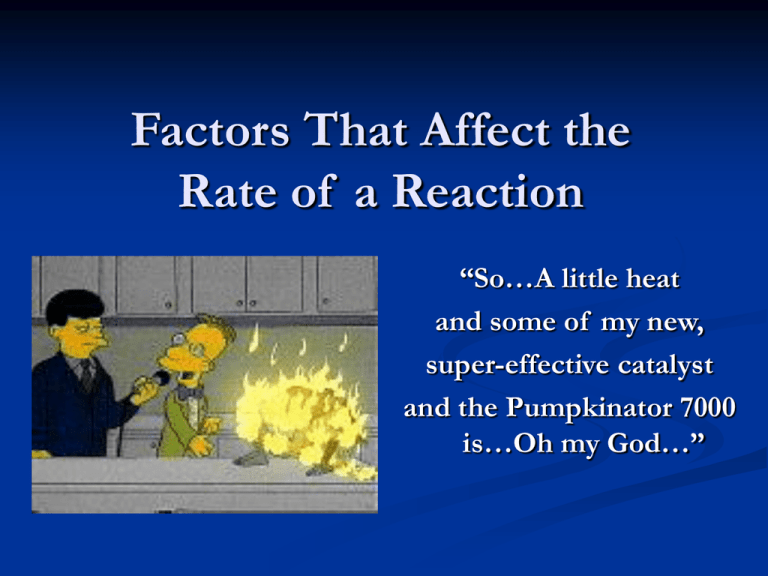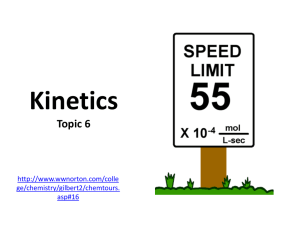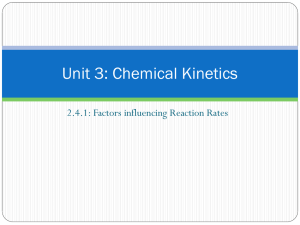Factors That Affect the Rate of a Reaction
advertisement

Factors That Affect the Rate of a Reaction “So…A little heat and some of my new, super-effective catalyst and the Pumpkinator 7000 is…Oh my God…” What is a Chemical Reaction? A chemical reaction occurs when the particles of the reactants collide with one another and stick together in new combinations to create new substances – these are the products. When the particles of the reactants strike one another and form a new substance, we can look at this as a “meaningful collision” – it gave us some product. We can manipulate/control several factors related to chemical reactions that will help us speed them up and get more product at a quicker pace. Before we examine these factors, we must look at the particles themselves and see how they behave and interact. The Fast & the Furious The nature of particles is addressed in what is known as the Particle Theory or, as it is also known, the Kinetic Molecular Theory (KMT). This theory has several simple points that discuss what matter really is and how the particles that make up matter really behave. 1. 2. 3. All matter is made of tiny particles that are constantly moving. The particles’ speed depends on the amount of energy they possess. The greater the energy; the greater the speed. The particles will move in a straight line until it strikes another particle. It will then bounce off of this particle and continue to move in a straight line, but in a new direction. Particles & State This illustration shows how the particles act in each of the three states of matter. SOLID LIQUID GAS A Real Smash Hit! When we see how the particles of a substance actually behave, we can then start to control this behaviour and get a chemical reaction to occur much quicker. To get a reaction to proceed at a quicker pace, we must get the particles involved to get into more of those “meaningful collisions” – we are talking about the high-impact type! The four factors that we can use to affect the rate of a chemical reaction are: 1. Temperature 2. Concentration 3. Surface Area 4. Catalysts These factors will help us by doing one of two things: speed up the particles and make the collisions more violent (and meaningful at the same time) increase the number of collisions overall and this should give us more meaningful type as well. Turning Up the Heat! The term “temperature” is used to indicate the amount of heat energy an object has. As you add more heat to an object, the particles of the reactants absorb this heat and start moving faster and faster. This makes the collisions between the particles much more violent and meaningful – the formation of product will increase quickly. So…As temperature increase; reaction rate increases. Examples: Using a Bunsen burner to heat a test tube in a lab. Baking a cake in an oven. “Made From Concentrate” Concentration is the number of particles in a given volume of space. As you increase the concentration of substance, you are increasing the number of particles in the reaction. This means that you will have a higher number of collisions and a greater chance that some of those collisions will be the “meaningful” type. So…As concentration increases; the reaction rate increases as well. Examples: Using a more concentrated acid to etch some glass. Adding more octane to gasoline to burn more efficiently. Chemicals Exposing Themselves?!?! Surface area is the amount of a substance that is exposed to the outer environment. When substances are going to react with one another, they have to collide and this means that the surface of one substance must fit the surface of the other substance. The more surface area a substance has exposed; the more particles are exposed to and are able to react with other particles. You are now able to have more collisions taking place – more collisions means more chances of “meaningful collisions” taking place. So…As more surface area is exposed on a substance; the faster the rate of reaction Examples: Grinding up a metal block into powder for a reaction. Using wood chips and kindling to start a fire. Catalysts A catalyst is a substance that increases the rate of a reaction by lowering the activation energy required by the reaction. The activation energy is the amount of energy that a reaction needs to get started. It’s like the spark needed to get a can a gasoline to explode. A catalyst helps turn the reactants into products without becoming a product in the reaction – it is not consumed in the reaction like a fuel. There are biological catalysts called enzymes that allow the reactions in your body to proceed without consuming too much of your energy. So…The rate of reaction is quicker when a catalyst is used. Examples: Digestive enzymes in your body breaking down your food. A catalytic converter in a car breaking apart the contaminants in exhaust. THE END







